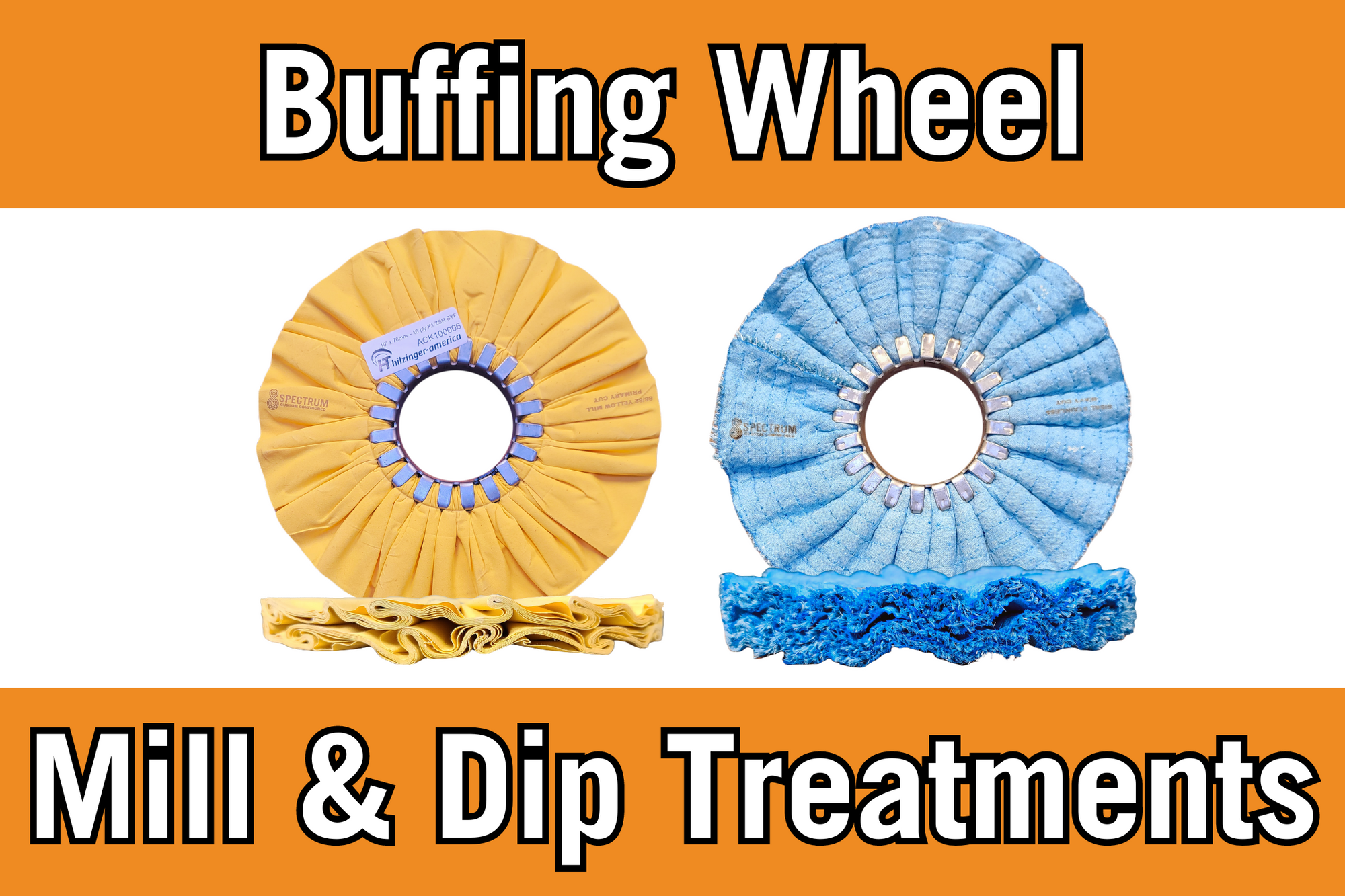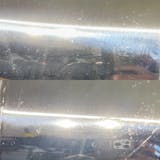Traditionally, buffing wheels were made firmer by adding rows of stitching to the material. Now, we can utilize mill and dip treatments to enhance the polishing action and lifespan of a buffing wheel.
To get something out of the way early, repeat after me: Treatment colour is manufacturer-specific and NOT a good indication of a buffing wheel's purpose in-and-of-itself. That said, two relatively standard industrial treatments in North America are Yellow (Maize) and Clear (Unifirm), which tend to be middling in firmness.
What are mill and dip treatments?
- Mill treatments are applied to the fabric by a contract textile finisher or bleachery before conversion into a buffing wheel.
- Material can be double mill treated (although with diminishing returns).
- Dip treatments are applied to the material after it has been converted into a buff; this is accomplished by immersing a completed buff into a vat of chemical solution.
- One can differentiate a dip treatment from a mill treatment by examining the thread along the bias seam: if the seam is the same color as the buff material, it usually indicates that it was dipped. Stains on the clinch ring are also indicative of this type treatment.
- Although a variety of stiffness levels are available, dip treatments often feel firmer than mill treatments.
- Mill and dip treatments can be combined for exaggerated effect.
Although a variety of stiffness levels are available, dip treatments often feel firmer than mill treatments.
What is the purpose of treating buffing wheel material?
Buffing is a chemical and mechanical action. Regardless of the material used, a buffing wheel acts primarily as a carrier of abrasive compound to the part's surface. Thus, for developments to be beneficial, they must enhance the buff's compound retention (or at least not inhibit it), increase its mass (and therefore, efficiency of buffing action), increase firmness (to apply compound more aggressively) or flexibility (to apply compound more effectively to uneven surfaces) and/or increase the lifespan of a buffing wheel.
A truly improved buff must cut and/or color faster for longer periods achieving the same or better (consistent) results for less money per finished piece.
Treatments can come with disadvantages: for example, a buff that has become more aggressive after treatment will remove stock material faster but will also tend to leave more visible buffing lines; if it takes longer to complete the entire process as a result, the treatment has become counterproductive.
What factors are most important in mill and dip treatment design?
- Base material (cotton, sisal, etc.), thread count, yarn size, weight
- Each will absorb treatment to varying degrees and have more or less capacity available for compound retention afterwards.
- Larger yarn sizes will tend to absorb more treatment, gain mass, and retain their structure during use better than narrower fibers.
- Dip treatments tend to add more mass and therefore, overall buffing action when equally firm.
- Firmness, solids content, heat resistance
- Although overall firmness is partially dependent on base textile quality (think of a hard treatment on low-quality fabric as paper maché - hard until it isn't), different treatments impart varying degrees of firmness.
- Special treatments can enhance the flexibility and elasticity of coarser fibers.
- Firmness and "coarseness" of the fabric is affected by the solids content of the treatment:
- Higher quality solids tend to perform better both in retained firmness and minimized excess buffing lines.
- Higher solids content means more firmness and more abrasion resistance
- More, higher quality solids = higher cost
- A treatment, even if not spectacularly firm, can perform extremely well with the right solids
- How well a treatment resists "going soft" is dependent in part on the chemicals used for heat resistance:
- More heat resistance = higher cost
- Excessive heat (e.g., excessive buffing RPMs) can result in reduced treatment performance (e.g., loss of firmness, faster wear)
- Compound Retention
- Some fibres naturally hold compound well (cotton), while others do not (sisal fiber).
- Wax-based treatments can enhance the lubrication and compound retention capacity of a buff.
- Excessive or poorly designed treatments in combination with the wrong textiles can reduce the compound carrying capacity of a buffing wheel, making your process significantly less efficient.
- Dip treatments, by their nature, frequently have a short break-in period as the fibres have often been completely encased in the treatment.
Not all treatments are created equal - Hilzinger uses higher quality base material and treatments to enhance buff performance, while other producers frequently use treatments to compensate for lower quality material.
Our customers frequently report that our Spectrum Custom Configured buffing wheels by Hilzinger produce cleaner results in less time, with less buff wear. Hilzinger's sisal buffing wheels and light blue dip treatment are particularly impressive, producing an aggressive cut on stainless steel with fewer buffing lines than our former Osborn sisal buffs - and (in our experience) a lifespan up to 10x (in part due to Hilzinger's commitment to quality base material)!


